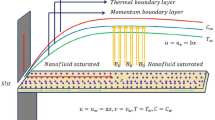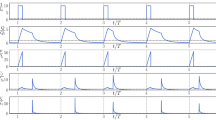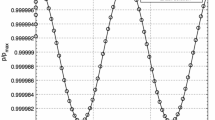Abstract
It has been shown in earlier studies that the maximum electrokinetic conversion efficiency between flow and electric work (e.g., electrokinetic power generation) occurs when electric double-layer (λ) overlaps and there is no electroneutral zone in a nanometer-scale channel. This result has been shown through cumbersome and lengthy numerical and theoretical studies. The case is made here that complications associated with solving the coupled set of governing equations i.e. Poisson, Nernst-Planck, and Navier-Stokes (PNPNS) could be drastically reduced to a two-step solution by method of intersecting asymptotes.
Similar content being viewed by others
Introduction
The theory of electrokinetic transport in micro/nano channels, particularly in the analysis related to the calculation of maximum electrokinetic energy conversion has been developed over the years, with several key studies1,2,3,4,5,6,7,8,9,10,11,12. The pressure-driven electrokinetic flows in such geometries can be modeled in the framework of a coupled problem between modified Navier-Stokes and Poisson-Nernst-Planck equations, where the electrochemical transport of electrolyte solution and the ion transports by convection, diffusion, and migration are described, respectively. In this paper we employ the method of intersecting asymptotes to simplify the electrokinetic energy conversion problem. This method has been employed to explore complicated multi-physics phenomena and it is helpful to describe the phenomenon in the simpler extremes (asymptotes) in which it may manifest itself. The intersection of asymptotes method provides a direct and shortcut to capture the most important characteristics of the problem13. The method consists of only two steps, initially to find the functional form of the solution in the two possible extremes, in case of the current problem i.e. electrokinetic transport in a nanochannel with radius of “r” the two extreme cases are: thin (λ ≪ r) and thick (λ ≫ r) double layer assumptions. In the second step, the two asymptotes graphically are intersected to determine the radius of a nanochannel that identifies a potential extremum (in this case a maximum) in the electrokinetic energy conversion efficiency.
In electrokinetic power generation the source of current is the transport of ions by pressure driven flows. The origin of such streaming current is the electrical state of the fluid-substrate interface that creates a spatial distribution in the free charge density, which is then transported by the fluid velocity, u, parallel to the walls. The streaming current is the product of velocity field and net charge density and is given by.
The description of the free charge density ρ(r) depends upon whether we apply the thin or thick double-layer assumptions. We begin by invoking the thin double-layer assumption and, for simplicity, the Debye-Huckel approximation in which the electrical potential within the double layer is assumed to be small (<25.7 mV at 25C for water-glass interface). The streaming current can then be written as a function of either constant surface change density or constant surface potential as below14,15.
where ε is the fluid permittivity, ζ is the zeta potential, σ is the surface charge density, \({\rm{\lambda }}\sim \sqrt{\frac{\varepsilon {K}_{b}T}{2{e}^{2}{n}_{\infty }}}\) is the Debye length and εζ = σλ, µ is the viscosity, ΔP/L is pressure gradient, T is the temperature, Kb is Boltzmann constant and r is the radius of the channel. We now invoke the other extreme i.e. the thick double-layer assumption where the total surface charge on the nanochannel should be balanced by the excess of counterions within the electrolyte solution and streaming current can be then written as16.
The theoretical electrokinetic energy conversion efficiency of fluid flow to electric power in a single nanochannel can be obtained by dividing the rate of electric work over the rate of flow work. The rate of electric work is expressed by \(\,{\dot{w}}_{el}={I}^{2}R\) where I is the streaming current and R is the total electrical resistance of the nanochannel. The electrical resistance of a nanochannel is a function of electrolyte conductivity (K) and geometry and its expressed as \(R=\frac{L}{\pi {r}^{2}K}\) where L is the length of nanochannel. The rate of flow work is the product of volumetric flow rate (Q) and pressure difference across the nanochannel \({\dot{w}}_{fl}=\Delta Q\Delta P\). The theoretical electrokinetic energy conversion is simply expressed as \(\eta =\frac{{\dot{w}}_{el}}{{\dot{w}}_{fl}}\). The quest for optimal/maximizing energy conversion efficiency has been long and drives us to seek simpler solutions in this study. First consider the thin-double layer assumption where double layer thickness is much smaller than the radius of the channel. It can be shown that for a thin double layer, the electric conductivity of the electrolyte solution is inversely proportional to the square of double layer thickness \(K\sim \frac{2D{e}^{2}{n}_{\infty }}{{K}_{b}T}\sim \,\frac{\varepsilon D}{{{\rm{\lambda }}}^{2}}\sim \frac{1}{{{\rm{\lambda }}}^{2}}\) where D is the ion diffusivity17,18. The volumetric flow rate is estimated by Hagen-Poiseuille equation \(Q=\,\frac{{{\rm{\pi }}r}^{4}{\rm{\Delta }}{\rm{P}}}{8\,\mu {\rm{l}}}\sim {r}^{4}\) as velocity is obtained by Poiseuille equation \(V\sim \frac{1}{4\,\mu }({r}^{2}-{a}^{2})\frac{\Delta p}{L}\sim {r}^{2}\) and surface area A ~ r2 in a circular channel. Substituting above correlations into the efficiency equation, it can be further simplified as below.
The efficiency for thin-double layer assumption (i.e. a microchannel) can be expressed as a function of \({(\frac{{\rm{\lambda }}}{r})}^{2}\), it increases rapidly with Debye screening length and decrease with channel radius and the maximum power varies as Pmax ~ r2. Now considering the thick-double layer assumption where double layer thickness is much larger than the radius of channel. It can be shown that for a thick-double layer, due to balance between surface charges and counterions inside the nanochannel the electric conductivity of the electrolyte solution is directly proportional to the surface charge on the channel wall and is inversely proportional to channel radius \(K\sim \frac{\sigma }{r}\) 19. Substituting previous correlations into the efficiency equation for thick double layer assumption, it can be further simplified as below.
The efficiency for the thick-double layer assumption (i.e. a nanochannel) can be expressed as a function of \({(\frac{{\rm{\lambda }}}{r})}^{-1}\), and contrary to thin-double layer assumption, it decreases with Debye length and increases with the nanochannel radius and the maximum power varies as Pmax ~ r5. Similar to a circular nanochannel, the efficiency of electrokinetic energy conversion in a nanoslit is directly proportional to both nanoslit height and surface charge density2.
What we have determined so far are the two asymptotes of the curves of electrokinetic energy conversion efficiency (η) versus non-dimensional Debye length \((\frac{{\rm{\lambda }}}{r})\) with respect to channel radius. As shown in Fig. 1 by plotting the two asymptotes we find the maximum electrokinetic energy conversion efficiency occurs within the range of double-layer overlap i.e. roptimum ~ λ. The extended electric double layer enhances the concentration of counter-ions in the center of the nanochannel where the velocity fields are extreme thus maximizing the efficiency1,2,3,4,5,6,7,8,9,10,11,12. Daiguji et al. through a detailed numerical study showed the efficiency of electrokinetic energy conversion in a nanoslit is also maximized when Debye length is in the order of half of channel height. In double layer overlap regime, a unipolar electrolyte solution is generated inside the nanochannel to sustain the electrical neutrality2. In Fig. 1 the thin and thick models become increasingly inaccurate as they approach the other model’s point of validity, yet they produce the same result at value of unity on x-axis. Similar analysis can be performed for electroosmotic pumping (reverse effect of streaming potential/power generation, i.e. generating fluid flows by applying potential differences) where \(\,{\eta }_{pumping}=\frac{\Delta P\Delta Q}{{I}^{2}R}\). Yao et al. showed that maximum electrokinetic energy conversion efficiency in electroosmotic pumping also occurs in double-layer overlap regimes20. In addition, non-equilibrium thermodynamic theory has shown that the maximum efficiency in either direction of electrokinetic energy conversion is the same21.
We have shown through a simple but effective mathematical method (intersecting asymptotes) that the electrokinetic energy conversion efficiency can be maximized in the range of double layer overlap. While our findings are in excellent agreement with previous detailed modeling studies, we showed that the method of intersecting asymptotes is a powerful and useful tool for simplifying sophisticated multi-physics systems. We anticipate that further applications of this method will facilitate the solution of electrokinetic optimization problems.
Change history
11 April 2019
A correction to this article has been published and is linked from the HTML and PDF versions of this paper. The error has not been fixed in the paper.
References
Morrison, F. A. Jr. & Osterle, J. F. Electrokinetic energy conversion in ultrafine capillaries. The Journal of Chemical Physics. 43(6), 2111–2115 (1965).
Daiguji, H., Yang, P., Szeri, A. J. & Majumdar, A. Electrochemomechanical energy conversion in nanofluidic channels. Nano letters. 4(12), 2315–2321 (2004).
Van der Heyden, F. H., Bonthuis, D. J., Stein, D., Meyer, C. & Dekker, C. Electrokinetic energy conversion efficiency in nanofluidic channels. Nano letters. 6(10), 2232–2237 (2006).
Yang, J., Lu, F., Kostiuk, L. W. & Kwok, D. Y. Electrokinetic microchannel battery by means of electrokinetic and microfluidic phenomena. Journal of Micromechanics and Microengineering. 13(6), 963 (2003).
Xuan, X. & Li, D. Thermodynamic analysis of electrokinetic energy conversion. Journal of Power Sources. 156(2), 677–684 (2006).
Lu, M. C., Satyanarayana, S., Karnik, R., Majumdar, A. & Wang, C. C. A mechanical-electrokinetic battery using a nano-porous membrane. Journal of Micromechanics and Microengineering. 16(4), 667 (2006).
Mansouri, A., Bhattacharjee, S. & Kostiuk, L. High-power electrokinetic energy conversion in a glass microchannel array. Lab on a Chip. 12(20), 4033–4036 (2012).
Chang, C. C. & Yang, R. J. Electrokinetic energy conversion in micrometer-length nanofluidic channels. Microfluidics and Nanofluidics. 9(2–3), 225–241 (2010).
Pennathur, S., Eijkel, J. C. T. & van den Berg, A. Energy conversion in microsystems: is there a role for micro/nanofluidics? Lab on a chip. 7(7/10), 1234–1237 (2007).
Haldrup, S. et al. Tailoring membrane nanostructure and charge density for high electrokinetic energy conversion efficiency. ACS nano. 10(2), 2415–2423 (2016).
Catalano, J., Hamelers, H. V. M., Bentien, A. & Biesheuvel, P. M. Revisiting Morrison and Osterle 1965: the efficiency of membrane-based electrokinetic energy conversion. Journal of Physics: Condensed Matter. 28(32), 324001 (2016).
Zhang, Y., He, Y., Tsutsui, M., Miao, X. S. & Taniguchi, M. Short channel effects on electrokinetic energy conversion in solid-state nanopores. Scientific reports. 7, 46661 (2017).
Bejan, A. Shape and structure, from engineering to nature. Cambridge university press (2000).
Hunter, R. J. Zeta potential in colloid science. 1981. NY: Academic press New York (1986).
Mansouri, A. & Kostiuk, L. W. Giant streaming currents measured in a gold sputtered glass microchannel array. Chemical Physics Letters. 646, 81–86 (2016).
Jackson, M. D. & Leinov, E. On the validity of the “thin” and “thick” double-layer assumptions when calculating streaming currents in porous media. International Journal of Geophysics. 2012, 1–12 (2012).
Mansouri, A., Scheuerman, C., Bhattacharjee, S., Kwok, D. Y. & Kostiuk, L. W. Transient streaming potential in a finite length microchannel. Journal of Colloid and Interface Science. 292(2), 567–580 (2005).
Mansouri, A., Bhattacharjee, S. & Kostiuk, L. W. Transient electrokinetic transport in a finite length microchannel: currents, capacitance, and an electrical analogy. The Journal of Physical Chemistry B. 111(44), 12834–12843 (2007).
Ban, H., Lin, B. & Song, Z. Effect of electrical double layer on electric conductivity and pressure drop in a pressure-driven microchannel flow. Biomicrofluidics. 4(1), 014104 (2010).
Yao, S., Hertzog, D. E., Zeng, S., Mikkelsen, J. C. Jr. & Santiago, J. G. Porous glass electroosmotic pumps: design and experiments. Journal of Colloid and Interface Science. 268(1), 143–153 (2003).
Mazur, P. & Overbeek, J. T. G. On electro‐osmosis and streaming‐potentials in diaphragms: II. General quantitative relationship between electro‐kinetic effects. Recueil des Travaux Chimiques des Pays‐Bas. 70(1), 83–91 (1951).
Author information
Authors and Affiliations
Contributions
A.M. developed the concept and theoretical model. L.K. analyzed the results. A.M. wrote the main manuscript text. All authors reviewed the manuscript.
Corresponding author
Ethics declarations
Competing Interests
The authors declare no competing interests.
Additional information
Publisher’s note: Springer Nature remains neutral with regard to jurisdictional claims in published maps and institutional affiliations.
Rights and permissions
Open Access This article is licensed under a Creative Commons Attribution 4.0 International License, which permits use, sharing, adaptation, distribution and reproduction in any medium or format, as long as you give appropriate credit to the original author(s) and the source, provide a link to the Creative Commons license, and indicate if changes were made. The images or other third party material in this article are included in the article’s Creative Commons license, unless indicated otherwise in a credit line to the material. If material is not included in the article’s Creative Commons license and your intended use is not permitted by statutory regulation or exceeds the permitted use, you will need to obtain permission directly from the copyright holder. To view a copy of this license, visit http://creativecommons.org/licenses/by/4.0/.
About this article
Cite this article
Mansouri, A., Kostiuk, L. Maximizing Electrokinetic Energy Conversion via the Intersecting Asymptotes Method. Sci Rep 9, 750 (2019). https://doi.org/10.1038/s41598-018-37360-6
Received:
Accepted:
Published:
DOI: https://doi.org/10.1038/s41598-018-37360-6
Comments
By submitting a comment you agree to abide by our Terms and Community Guidelines. If you find something abusive or that does not comply with our terms or guidelines please flag it as inappropriate.




